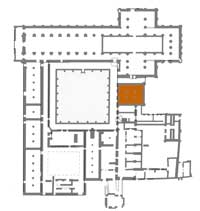 |
 |
 |
 |
 |
 |
 |
|
Byland Abbey: History
Byland Abbey: Buildings
|
The chapter-house
The chapter-house at Byland lay in the east range of the cloister, between the sacristy / library and the parlour. This was the typical location for a building of this kind, perhaps as it was one of the most inaccessible areas to outsiders and fairly well protected from the noise and bustle of daily life. The chapter-house was vaulted and supported by four piers, one of which survives in the south-east. It was slightly lower than the cloister and extended east of the range by one bay. The chapter-house was accessed from the cloister by a large central door, with a window on either side forming three openings, in memory of the Trinity.(25) The chapter-house
was a focal point of monastic life. It was here that the monks
gathered for an hour each day to attend the chapter
meeting, so called as proceedings began with the reading of a chapter
from the Rule
of St Benedict. The monks sat on tiered stone benches
around the walls, and the remains of these are still visible. The
abbot, or his deputy who presided in his place, occupied a pulpit
in the eastern part of the room. There was also a lectern here
for the reader and the base of this survives and can be seen in
the abbey museum. There were other occasions when the community
gathered in the chapter-house, for example, to discuss business
or to welcome a distinguished visitor, and the entire community
gathered here on feast days when the abbot delivered a sermon. The chapter-house was a common place for the burial of abbots, especially before this was permitted in the abbey church. The remains of two tomb slabs can still be seen, but there would have been many more here during the Middle Ages. It is thought that some of the slabs that are now in the churches at Brafferton, Kilburn and Oswaldkirk came originally from the chapter-house at Byland.(26)
In the later Middle Ages it was believed that
Byland’s founder,
Roger de Mowbray, was buried in Byland’s chapter-house, even
though contemporary accounts stated that he had died and was buried
in Palestine shortly after his capture in 1188. In the nineteenth
century the chapter-house was excavated to find his tomb. |
 (1/3)
(1/3)